
French postcard by Editions P.I., Paris, no. 408, 1952. Photo: George Hurrell / Paramount. Veronica Lake in This Gun for Hire (Frank Tuttle, 1942).
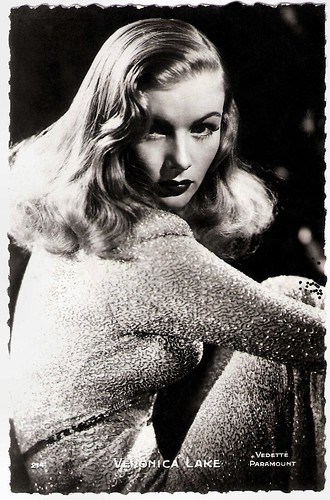
French postcard by Editions P.I., Paris, no. 214. Photo: Eugene Robert Richee / Paramount. Publicity still for I Wanted Wings (Mitchell Leisen, 1941).
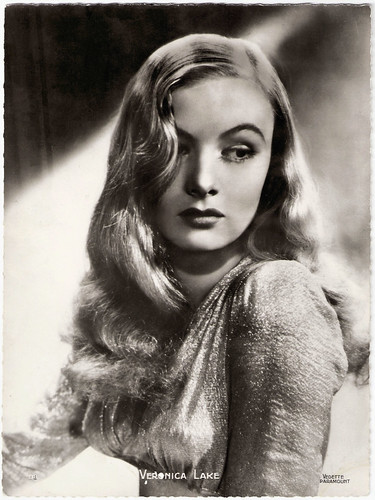
Big Belgian card by Chocolaterie Clovis, Pepinster. Photo: George Hurrell / Paramount. Publicity still for This Gun for Hire (Frank Tuttle, 1942).
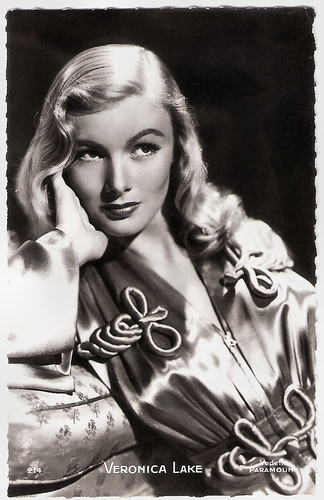
French postcard by Editions P.I., Paris, offered by S.A. Victoria, Brussels, no. 214, 1950. Photo: Paramount.
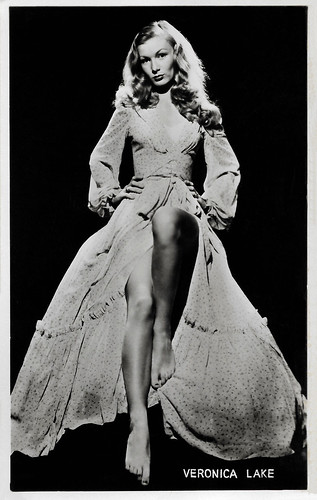
Dutch postcard, no. 1. Photo: Metro-Goldwyn-Mayer.
Peek-a-boo bang
Veronica Lake was born Constance Frances Marie Ockelman in Brooklyn, New York, in 1922. Lake grew up in poor circumstances. Her father, Harry Eugene Ockelman, worked for an oil company aboard a ship. He died in an oil tanker explosion in 1932. The following year, Lake's mother, Constance Frances Charlotta (née Trimble), married Anthony Keane, a newspaper staff artist and Lake began using his surname.
She moved with her mother from Miami to Beverly Hills after high school. At 16, she attended an acting school there and her career began not much later. In 1939 she had a small role as one of several students in the film Sorority House (John Farrow, 1939). Farrow introduced her to Paramount Pictures producer Arthur Hornblow Jr. who gave her the stage name Veronica Lake.
In Forty Little Mothers (Busby Berkeley, 1940), she let her hair down on the screen for the first time. In 1941, she was signed by Paramount. Lake received the supporting role of a nightclub singer in the military drama I Wanted Wings (Mitchell Leisen, 1941), starring Ray Milland and William Holden. Although her part was small, Lake ultimately stole the show and although still in her teens, Lake became a star. It was during the filming of I Wanted Wings that she developed her signature look. Audiences were especially fascinated by her hairstyle which became famous under the name 'peek-a-boo bang' and the studio presented her as 'the peek-a-boo girl'.
She starred in the Film Noir This Gun for Hire (Frank Tuttle, 1942). Robert Preston was her love interest, but she shared more scenes with Alan Ladd. The two were so popular together that they would be reteamed in lead roles for three more films, including The Glass Key (Frank Tuttle, 1942). Lake had another good role in the comedy Sullivan's Travels (Preston Sturges, 1941) alongside Joel McCrea. She starred with Fredric March in the title role of the comedy I Married a Witch (René Clair, 1942). Lake had a cameo in the all-star propaganda revue Star Spangled Rhythm (George Marshall, a.o., 1943). She sang the song 'A Sweater, a Sarong and a Peek-A-Boo' alongside Dorothy Lamour and Paulette Goddard.
In the same year, she had one of her best roles in So Proudly We Hail! (Mark Sandrich, 1943) alongside Claudette Colbert and again Paulette Goddard. The drama about nurses who are trapped by the Japanese in Bataan and suffer a terrible fate was one of the first Hollywood productions to depict the everyday lives of female army personnel. She also became a popular pin-up girl for soldiers during World War II and travelled throughout the United States to raise money for war bonds.
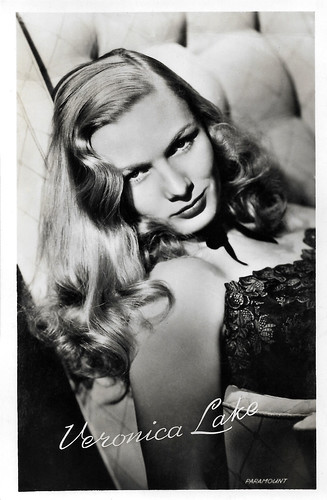
Dutch postcard by Foto-archief Film en Toneel, no. 3443. Photo: Paramount.

Vintage postcard, no. 354. Photo: Paramount.

West-German postcard by Kunst und Bild, Berlin, no. A 361. Photo: Paramount.
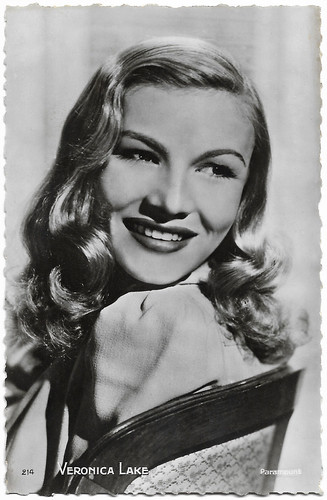
Vintage postcard by Editions P.I., Paris, no. 214. Photo: Paramount.
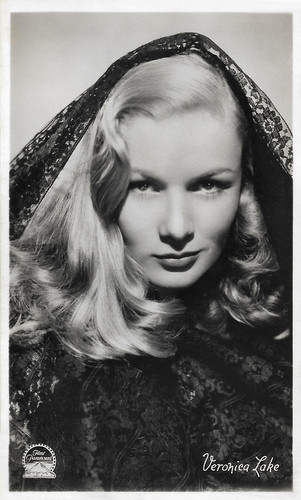
Belgian card by Fotoprim, Brussels, for De Beukelaer, Antwerp, no. A 33. Photo: Paramount.
Public drunkenness and disorderly conduct
Veronica Lake's Peek-a-Boo hairstyle was a sensation and was copied millions of times. But when accidents occurred in factories because workers got their hair caught in the production machines and were scalped, the US government asked Lake to wear a different hairstyle. Curiously, Lake's career was over soon after. One of her last significant roles was alongside Alan Ladd in The Blue Dahlia (George Marshall, 1946), based on an original screenplay by Raymond Chandler.
Although popular, Lake was known to be difficult to work with. During the filming of The Blue Dahlia (1946), Raymond Chandler referred to her as "Moronica Lake". Psychological problems are said to have been the reason for her behaviour. She also drank heavily and later became an alcoholic. Her contract with Paramount was not renewed because of this.
She made her first film outside Paramount since she became a star, a Western, Ramrod (1947), directed by her then-husband André De Toth, which reunited her with Joel McCrea. Lake had a career in the television industry in the first half of the 1950s. She performed in summer stock theatre and in stage roles in England, but after she broke her ankle, she had to quit.
She deteriorated more and more, both mentally and physically. After her third divorce, Lake drifted between cheap hotels in New York City and was arrested several times for public drunkenness and disorderly conduct. In the early 1960s, she worked as a waitress in the cocktail lounge of the hotel where she lived. She was diagnosed with paranoia in the 1960s.
In 1966 she tried to make a comeback with the low-budget independent Canadian thriller Footsteps in the Snow (Martin Green, 1966). Her last film was the horror film Flesh Feast (Brad F. Grinter, 1970) for which she also acted as producer. It was filmed in 1967 but not released until 1970. Both films failed to revitalise her career. Lake's memoirs, 'Veronica: The Autobiography of Veronica Lake', which she dictated to the writer Donald Bain, were published in the United Kingdom in 1969, and in the United States the following year. In the book, Lake discusses her career, her failed marriages, her romances with Howard Hughes, Tommy Manville and Aristotle Onassis, her alcoholism, and her guilt over not spending enough time with her children.
Only 50, Veronica Lake died of a liver infection in Burlington, Vermont, in 1973. It was a consequence of her decades-long alcoholism. Veronica Lake was married four times, in her first marriage to director John S. Detlie and in her second marriage to director André De Toth. Her body was cremated and scattered off the coast of Florida.
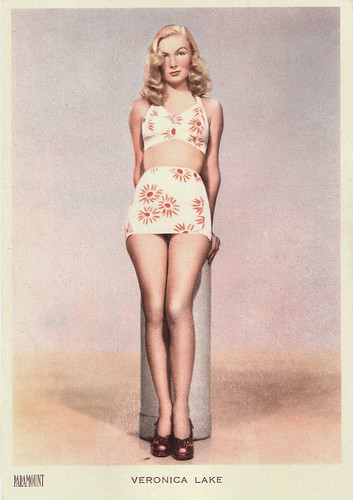
Vintage postcard by GM. Photo: Paramount.
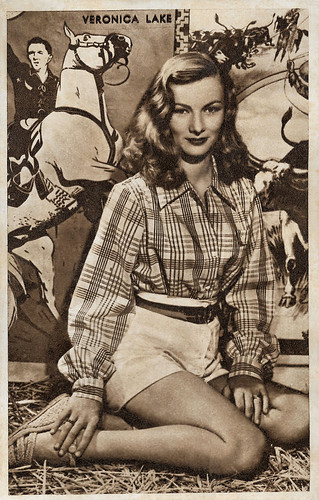
Vintage card.
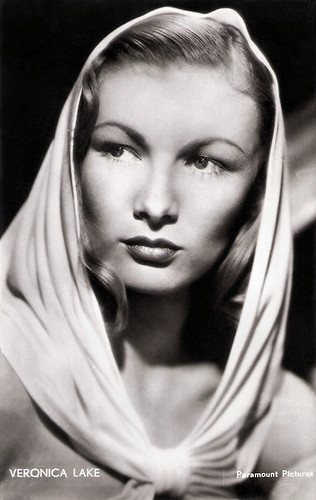
Vintage postcard, no. AX 164. Photo: Paramount Pictures.

Dutch postcard.
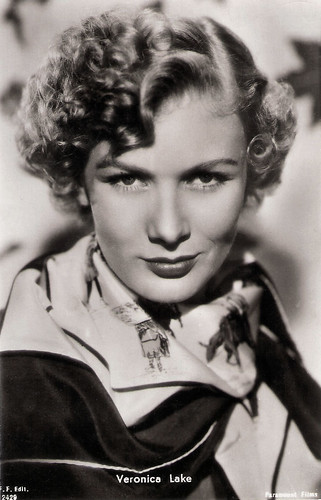
Italian postcard by B.F.F. Edit. (Casa Editr. Ballerini & Fratini, Firenze), no. 2429. Photo: Paramount. Sadly, a former owner cut the edges of this card.

British postcard by Moviestar, no. F 04.
Sources: Wikipedia (Dutch and English), and IMDb.
No comments:
Post a Comment